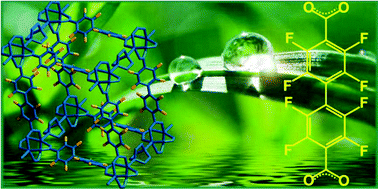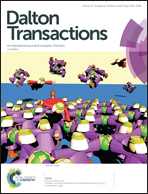Metal–organic frameworks based on octafluorobiphenyl-4,4′-dicarboxylate: synthesis, crystal structure, and surface functionality†‡
Abstract
In contrast to aromatic carboxylates, the coordination polymers based on their perfluorinated analogues are not numerous. Here we present a series of six Zn(II) coordination polymers of different dimensionalities (1D, 2D, and 3D) and porosities based on octafluorobiphenyl-4,4′-dicarboxylate (oFBPDC2−) and N-containing co-ligands (ur, dabco, and bpy). These complexes are characterized by single-crystal X-ray diffraction, PXRD, FT-IR, elemental analysis, and TGA. The metal–organic frameworks [Zn2(CH3CONH2)2(oFBPDC)2] (1) and [Zn2(oFBPDC)2(dabco)] (4) are shown to be porous with BET surface areas of 470 m2 g−1 and 441 m2 g−1, respectively. In addition, compound 4 shows selectivity factors of 11.3, 4.9 and more than 6 for the binary gas mixtures CO2/N2, CO2/CH4 and benzene/cyclohexane, respectively. The measurements for pressed powders and water droplet give water contact angles of 136° for 4 and 133° for (H2bpy)[Zn2(bpy)(oFBPDC)3] (5). Low water uptake indicates that both 4 and 5 belong to highly hydrophobic solids.



 Please wait while we load your content...
Please wait while we load your content...